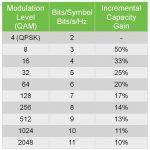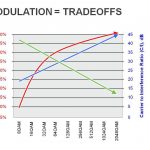1. What is QAM?
Modulation is a data transmission technique that transmits a message signal inside another higher frequency carrier by altering the carrier to look more like the message. Quadrature Amplitude Modulation (QAM) is a form of modulation that uses two carriers—offset in phase by 90 degrees—and varying symbol rates (i.e., transmitted bits per symbol) to increase throughput. The table in this blog post (Figure 1) describes the various common modulation levels, associated bits/symbol and incremental capacity improvement above the next lower modulation step.

2. Must all operators who use microwave backhaul use higher-order QAMs?
Higher-order QAMs are not necessarily a must-have for all network operators. However, higher-order modulations do provide one method of obtaining higher data throughput and are a useful tool for meeting LTE backhaul capacity requirements.
3. What is the main advantage of using higher-order QAMs with microwave radios?
The main advantage is increased capacity, or higher throughput. However, capacity improvement diminishes with every higher modulation step (i.e., moving from 1024QAM to 2048QAM the improvement is only about 10 percent!), so the real capability of higher-order modulations alone to address the objective of increasing capacity is very limited. Other techniques will be needed.
4. What are the tradeoffs of higher-order QAMs on RF performance?
First, with each step increase in QAM the RF performance of the microwave radio is degraded as per the Carrier-to-Interference (C/I) ratio. For example, going from 1024QAM to 2048QAM will produce an increase of 5 dB in C/I (Figure 2). This results in the microwave link having much higher sensitivity to interference, making it more difficult to coordinate links and reducing link density. Along with this increase in phase noise there will be an increase in design complexity cost.

Also, by increasing from 1024QAM to 2048QAM, system gain will decrease from above 80 dB to just above 75 dB (Figure 2). With much lower system gain microwave links will have to be shorter and larger antennas will have to be employed—increasing total cost of ownership and introducing additional link design and path planning problems.
All of the above are the results of linear functions: they degrade in a one-to-one relationship with the move to higher-order QAMs. Meanwhile, the capacity increases derived from higher-order QAMs are the function of a flattening curve: Each step increase in QAM results in a reduced percentage increase in capacity compared to prior increases in QAM. The added capacity benefits are diminished when considering the added costs of higher C/I and lower system gain.
5. Do you need to use Adaptive Coding and Modulation (ACM) while using higher-order QAMs?
ACM should be implemented while employing high-order QAMs to offset lower system gain. However, while ACM does help mitigate the effects of more difficult propagation when using higher-order modulations, it cannot help offset increased C/I.
6. What gives CableFree a “heads-up” here when other big name companies seem to be supporting the technology?
CableFree realizes higher-order modulations are not a panacea—a cure-all. While every minor technology improvement in throughput can help, a focus on technologies that grow capacity in hundreds of percentage points vs. tens of percentage points is most critical now. CableFree believes that these hundreds-of-percentage-points-of-improvement-in-capacity solutions will be the most important moving forward. It is in these technologies that CableFree has a “heads-up.” Such techniques include deploying more spectrum—particularly in the form of multichannel RF bonding (N+0) solutions—to achieve a minimum of 200 percent capacity increase. This technique is subject to frequency availability, but with flexible N+0 implementations (such as being able to use frequency channels in different bands and different channel sizes) many congestion issues can be avoided.
Second, intelligently dimensioning the backhaul network based on proven rules, best practices and L2/L3 quality of service (QoS) capabilities is another technique to provide potentially very large gains in backhaul capacity. Higher-order modulations can be one tool to achieve required capacity increases in the backhaul network. However, their inherent drawbacks should be well understood, while the most attention should be paid to other techniques that deliver more meaningful and quantifiable benefits.
7. Will operators need to “retrofit” microwave radios to be capable of higher-order QAM operation in their existing microwave infrastructure? Or will completely new hardware be required?
This depends on the age and model of the existing radios. Older microwave systems will likely need to be “retrofitted” to support 512QAM and higher modulations. Recently installed microwave systems should be able to support these technologies without new hardware.
8. How will QAM evolve in the future? Is the introduction of higher-order QAMs an indefinite process, with no end in sight?
The introduction of higher-order QAMs is not an endless process. As per Figure 1 above in this blog post, the law of diminishing returns applies: Throughput percentage improvement declines as modulation rates increase. The cost and complexity of implementing higher-order QAMs probably is not worth the capacity increase benefits derived—not past 1024QAM, in any event.
You must be logged in to post a comment.